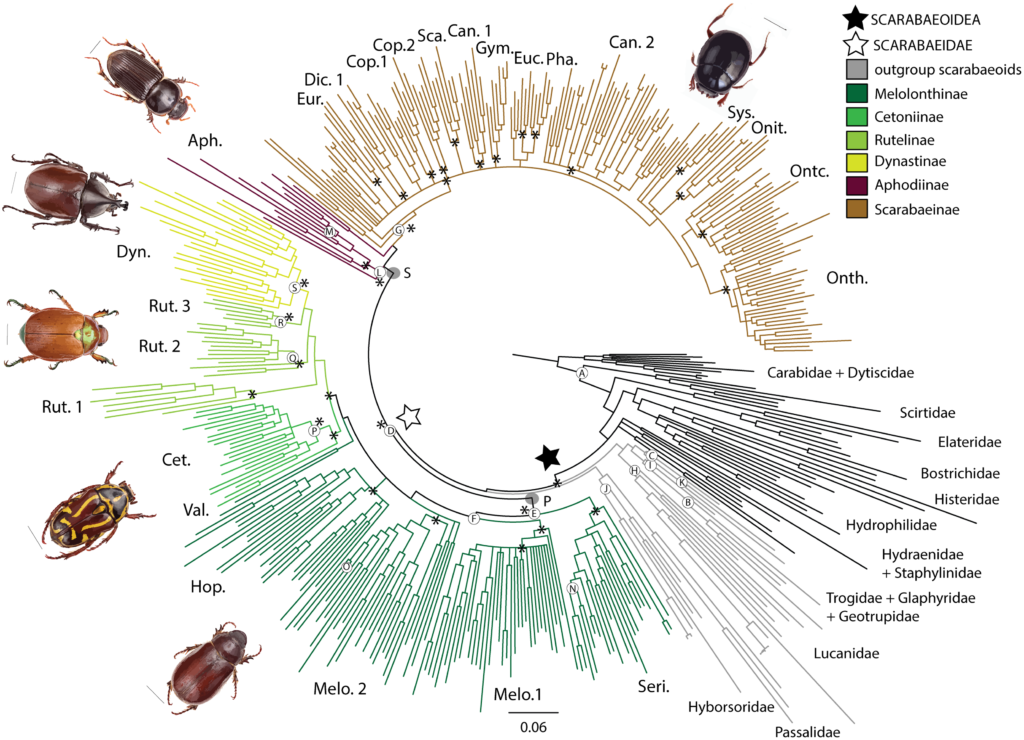WFS News: World Fossil Society,Riffin T Sajeev,Russel T Sajeev
The evolutionary success of beetles and numerous other terrestrial insects is generally attributed to co-radiation with flowering plants but most studies have focused on herbivorous or pollinating insects. Non-herbivores represent a significant proportion of beetle diversity yet potential factors that influence their diversification have been largely unexamined. In the present study, we examine the factors driving diversification within the Scarabaeidae, a speciose beetle family with a range of both herbivorous and non-herbivorous ecologies. In particular, it has been long debated whether the key event in the evolution of dung beetles (Scarabaeidae: Scarabaeinae) was an adaptation to feeding on dinosaur or mammalian dung. Here we present molecular evidence to show that the origin of dung beetles occurred in the middle of the Cretaceous, likely in association with dinosaur dung, but more surprisingly the timing is consistent with the rise of the angiosperms.

Bayesian Phylogeny of scarab beetles (Scarabaeidae).
Taxa color-coded by scarab subfamily, with outgroups in grey (superfamily) and black (other beetles). Grey circles indicate polyphagous (P) and saprophagous (S) lifestyles. White circles represent the node priors A-S as per Table 2.* represents nodes for which divergence dates are inferred. See also S1 Fig for posterior probability and terminal names.
We hypothesize that the switch in dinosaur diet to incorporate more nutritious and less fibrous angiosperm foliage provided a palatable dung source that ultimately created a new niche for diversification. Given the well-accepted mass extinction of non-avian dinosaurs at the Cretaceous-Paleogene boundary, we examine a potential co-extinction of dung beetles due to the loss of an important evolutionary resource, i.e., dinosaur dung. The biogeography of dung beetles is also examined to explore the previously proposed “out of Africa” hypothesis. Given the inferred age of Scarabaeinae as originating in the Lower Cretaceous, the major radiation of dung feeders prior to the Cenomanian, and the early divergence of both African and Gondwanan lineages, we hypothesise that that faunal exchange between Africa and Gondwanaland occurred during the earliest evolution of the Scarabaeinae. Therefore we propose that both Gondwanan vicariance and dispersal of African lineages is responsible for present day distribution of scarabaeine dung beetles and provide examples.
Citation: Gunter NL, Weir TA, Slipinksi A, Bocak L, Cameron SL (2016) If Dung Beetles (Scarabaeidae: Scarabaeinae) Arose in Association with Dinosaurs, Did They Also Suffer a Mass Co-Extinction at the K-Pg Boundary? PLoS ONE 11(5): e0153570. doi:10.1371/journal.pone.0153570
Editor: Ben J. Mans, Onderstepoort Veterinary Institute, SOUTH AFRICA



 June 12th, 2016
June 12th, 2016  Riffin
Riffin  Posted in
Posted in  Tags:
Tags: 